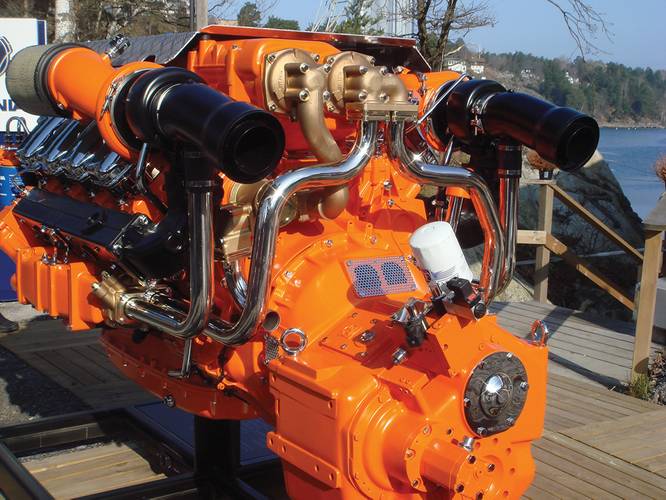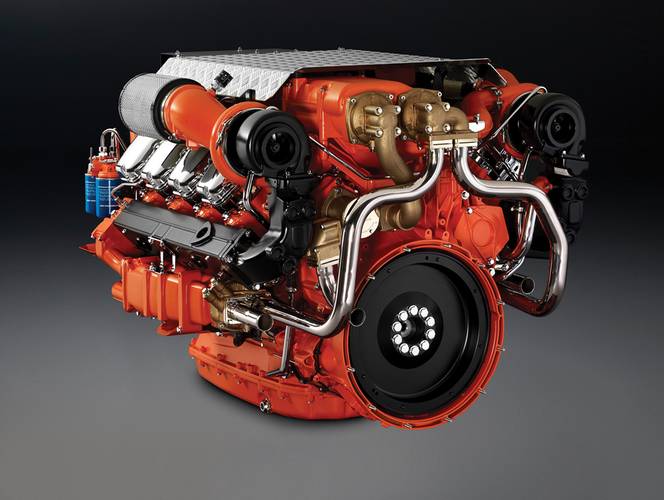New High-Speed SCANIA Marine Engine Range
With Outputs from 294 to 735 kW (400 to 1.000 HP)
SCANIA, a tradition rich Swedish industrial company celebrated in 2011 its 120-year existence. Very early, in 1902, the first engines for marine applications have been pro-duced. In fact, the market was considered so promising that the companies new factory, which was built in 1907, was described at the planning stage as “intended particu-larly for the manufacture of automobiles and boats”.
Without any doubts belongs SCANIA (named after the latin name of the Southern Swedish province Schonen), since 1996 a listed manufacturer of trucks, buses, marine and industrial engines, to the pioneers in the engine history.
Today it is a company with around 37.500 employees and a turnover of 87.7 billions SEK (13 billion US$). Figures end of 2011. Since 2008 SCANIA is part of the Volkswa-gen concern.
The 120-year history was very checkered. The enterprise originally goes back on two companies. The first enterprise runs under the name of Vagn Aktie Bolaget I Södertälje (VABIS) and was extablished in 1891 by Philip Wersen. Production were bicycles, railway coaches, horse buggies, in 1897 motor cars and from 1902 on also trucks.
The second enterprise was the in 1900 established Maskinsfabriks Aktiebolaget Scania in Malmö. Their prod-uct portfolio included boxcars for the Swedish State Rail-way plus rolled steel products – the production of motor cars began in 1901and of trucks in 1903.
Both companies merged in 1911 into Scania-Vabis, the common headquarter ever since was Södertalje. In 1968 Scania and Saab merged into Saab-Scania and since 1989 operates the concern under the name of SCANIA.
The enterprise is worldwide represented in about 100 countries. Research and development is based in Sweden, whereas production is located in Europe and South America. At this individual components and complete vehicles are global changeable.
To guarantee best quality (Made by SCANIA) the compa-nies philosophy is according the principle “ everything from one source”. Hence, “the best product quality and highest customer satisfaction” shall be reached.
SCANIA-Marine Engines
As mentioned before, the first engines for marine applica-tions have been produced in 1902. At the same time the engines were very much well-known for their outstanding reliability and low fuel consumption.
First tests with diesel engines started in 1927, but series production with own developed diesel engines started in 1936: 6-cylinder pre-chamber diesel engines with seven main bearings and output of 120 HP (88,8 kW).
The marine diesel engines of the Swedish manufacturer are installed in e.g. inland navigation vessels, coaster and sea-going ships, in passenger and authority ships, in life boats and trawlers. The today’s product range of the Swe-dish engine manufacturer for main and auxiliary drives starts with the 13-litre engine at 323 kW and ends with the 16-litre engine with 736 kW (1.000 HP). The speed range of both the engines is between 1.500 and 2.300 rpm. For Yanmar the company produces engines with outputs up to 660 kW for pleasure crafts.
The SCANIA engine philosophy is characterized by fun-damental factors: a high percentage of equal parts at the two series DI13 and DI16, high reliability, longevity, low fuel consumption combined with low emissions.
The amount of equal parts, the so called SCANIA module concept includes, beside others: pistons, cylinder liner, cylinder heads, gaskets, filters and unit-pump elements at the injection technology. The engines fulfill all existing worldwide current emission legislations. Each product, which is intended for ship application, passes a specific stringent test program which can run from 4 hours to 2 days.
The long-established company supplies the complete drive-line for ship propulsions from one source: engine – transmission – instruments. Coupling – shaft and propeller are assembled from chosen, strategic partners.
With the on-board gensets the company delivers the en-gine and the chosen partners contributing frame and in-strument panels
13- and 16-litre engines for propulsion and auxiliary
Scania’s engine range illustrates the essence of the think-ing: maximum uptime, proven reliability and outstanding operating economy. All this in compact and powerful packages built on Scania’s modular product system, which simplifies servicing and parts management, and facilitates individual specifications as well as volume production.
Power at the new in-line DI13 is available from 294 to 551 kW at speeds with 1.800 and 2.300 rpm for main-drives and outputs from 323 to 426 kW with speeds at 1.500 / 1.800 rpm for on-board gensets.
Scania introduces its new DI16 Marine Diesel Engine
The company will be show casting its new series of diesel engines for marine application, including the new DI16 series, at this year’s “Seawork” in the UK.
With the new DI 16 diesel engine, especially developed for applications in work boats as well as in patrol boats and yachts, Scania is aiming to consolidate its position in the marine market segment.
The turbocharged and aftercooled engine is available as 8-cylinder, in V-90 degrees configuration, only. With 130 mm bore and 154 mm stroke it features a displacement of 2.04 litres per cylinder. With the total displacement of 16.32 litres (a displacement increase of around 5% compared to the former DI 16 marine drive), the engine is capable of developing an output of 735 kW (1.000 HP). With this power increase Robert Sobocki, Vice President Engines, says: “we are now highly competitive with engines well above 16-litres”. The torque ratings of up to 3.340 Nm are particularly high for this output class. This ensures ample performance even at low revs, while facilitating running at favourable revs in all conditions, including high sea and high load.
Individual cylinder heads with 4 valves per cylinder pro-motes repairability and fuel economy. The new DI 16 ful-fills the emission standards IMO II, EU Stage IIIA and US Tier 2, Scania states. The engine is equipped with a Scania developed Engine Management System, EMS, in order to ensure the control of all aspects related to engine performance. The injection system is based on electronically controlled PDE unit injectors that gives low exhaust emissions with good fuel economy and a high torque already at low revs.
According to Scania: Vital for marine installations is that the engine is compact, has easy-to-fit auxiliaries and is designed for easy servicing. Scania's V8 engines traditionally meet all of these requirements thanks to the compact vee-design, which reduces the overall length. Ancillaries can be efficiently accommodated inside the ‘footprint’ of the engine.
Scania’s-Saver ring, placed at the top of each cylinder lin-er, reduces carbon deposits on the edge of the piston crown and reduces cylinder liner wear.
In spite of higher performance and tighter emission levels, Scania has been able to raise maintenance and oil-change intervals to 500 hours.
(As published in the June 2012 edition of Maritime Reporter & Engineering News)

















